
Revolutionizing Retail: How Handwave is Transforming Payments
As technology continues to reshape the retail landscape, the emergence of new payment solutions is both intriguing and vital for many businesses. Enter Handwave, a Latvian fintech startup poised to revolutionize the retail payment experience through innovative palm-scanning technology. This European alternative to Amazon’s popular palm payment system, Amazon One, not only addresses the demand for seamless transactions but also caters to retailers looking for reliable third-party solutions.
Why Palm Payments? Understanding the Shift
With contactless payments gaining widespread acceptance globally, the need for faster and more secure checkout methods has never been more critical. According to Handwave, the integration of palm vein recognition technology offers a significant advantage. This biometric method goes beyond mere image recognition, ensuring that only the legitimate user can authorize payments by scanning their palm vein patterns. This technology not only enhances security but streamlines the customer experience, making transactions quicker and more efficient.
The Competitive Landscape: What Sets Handwave Apart
While Amazon One has established a substantial foothold in the U.S. market, Handwave’s strategy diverges by focusing squarely on partnerships rather than store ownership. This agility positions Handwave uniquely in the market, enabling them to collaborate with various retailers across Europe. Unlike Amazon, which benefits from a vast ecosystem, Handwave aims to create a wide network of partners, tapping into their experience from Worldline—one of the world’s leading payment service providers. CEO Janis Stirna envisions a collaborative future, stating, "Our goal is to work with any financial institution or acquiring bank to build a broader ecosystem."
Partnerships Driving Growth: Handwave’s Collaboration with Visa
Recent agreements, such as the one with Visa, not only validate Handwave’s approach but also promise to expedite its deployment process throughout Europe. These strategic partnerships are critical for establishing credibility and expanding market reach. With Visa’s backing, Handwave is set to enhance its service offerings and potentially scale its operations rapidly, catering to the growing demand for biometric payment solutions.
Bridging the Gap: Understanding Consumer Needs
Beyond just technological advancements, Handwave exemplifies a deeper understanding of consumer behavior and market demands. The appeal of not needing cards, apps, or even biometric features like fingerprint scanning simplifies the payment process and can significantly enhance customer satisfaction. This emphasis on convenience and security addresses consumer preferences directly, thereby fostering a seamless shopping experience that could attract more shoppers to partner retailers.
Conclusion: The Future of Retail Payments
As the retail environment continues to change rapidly, Handwave is well-positioned to leverage its innovative palm scanning technology to meet the evolving demands of the industry. Their approach not only promises to facilitate faster checkouts but also prioritizes customer experience—an aspect critical for modern retail success. For retailers and businesses looking at future-proofing their payment systems, keeping an eye on solutions like Handwave could be essential.
As the landscape of payment solutions evolves, it's crucial for CEOs, marketing managers, and business professionals to stay informed about emerging technologies and partnerships within the fintech space. By understanding these innovations, businesses can strategically embrace changes that could enhance efficiency and drive customer engagement.
Take action today—explore the advancements in payment technology and consider how biometrics can revolutionize your retail operations.
 Add Row
Add Row  Add
Add 




Write A Comment